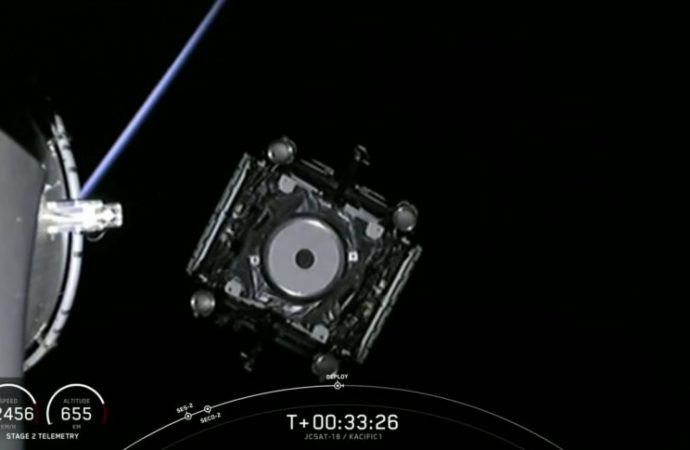SpaceX launched a communications satellite shared by two companies Dec. 16 using a Falcon 9 rocket.
Source: Space News
The rocket lifted off at 7:10 p.m. Eastern from Cape Canaveral, Florida, and deployed the JCSAT-18/Kacific-1 satellite into a geostationary transfer orbit 33 minutes later.
The Falcon 9’s first-stage booster, previously used for NASA cargo runs to the International Space Station in May and July, landed on the Atlantic droneship Of Course I Still Love You almost nine minutes into the mission, returning to Earth for the third time.
SpaceX said its fairing recovery ships Ms. Tree and Ms. Chief “narrowly missed catching the fairing halves” from the launch, but that SpaceX is still working to recover them from the ocean for potential use on a future flight.
JCSAT-18/Kacific-1 is a 6,800-kilogram condominium satellite, or “condosat” from Boeing, equipped with distinct payloads for Japanese operator Sky Perfect JSAT and Singaporean startup Kacific.
For Sky Perfect JSAT, the JCSAT-18 payload will provide Ku- and Ka-band capacity over large parts of the Asia-Pacific, including Russia’s Far East. It is the 18th geostationary satellite in the operator’s fleet, and second with high-throughput capacity, enabling higher speed broadband services than traditional satellites.
Kacific-1 is an all Ka-band payload with high-throughput coverage designed for island nations that lack dedicated satellite coverage. Kacific says the payload’s 56 spot beams will cover 600 million people spread across 25 countries.
Kacific-1 is Kacific’s first satellite, and almost didn’t happen because of difficulty attracting capital. Christian Patouraux, Kacific’s CEO, said that for its first three years he felt the company was constantly within a month of collapsing.
“There were ups and downs,” he said during a Dec. 16 press conference. “There were roller coasters.”
Kacific formed in 2013, he said. When Kacific ordered Kacific-1 in 2017, it had to do so without help from the U.S. Export-Import Bank, which lacked the minimum number of Senate-confirmed board members required to finance deals over $10 million.
Patouraux said Kacific raised $67 million in equity for the satellite through family offices — many backed by high-net-worth individuals — to finance the satellite. Kacific also used short term debt, which it refinanced with $160 million in new debt announced Dec. 5.
Patouraux said Kacific contracted 11 transponders of Ku-band capacity from European and Asian satellite operators so it could serve customers in Vanuatu, Samoa, Timor Leste, and elsewhere while waiting for Kacific-1.
Kacific selected Kratos to build gateway ground stations in Indonesia, Australia and the Philippines to support Kacific-1. After all the work required to launch a first satellite, Patouraux said it would be much easier to order and launch a second satellite, which the company plans to do pending board approval.
“It would almost be silly not to try to replicate that and do it in faster time with a better cost of capital,” he said.
Patouraux said a Kacific-2 satellite would augment Kacific-1 capacity while expanding westward across Asia and possibly Africa. He did not give a timeline for Kacific-2.
Source: Space News

































Leave a Comment
You must be logged in to post a comment.